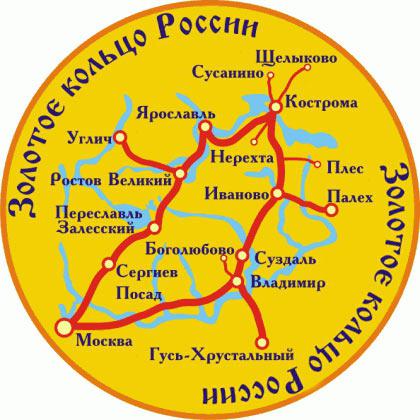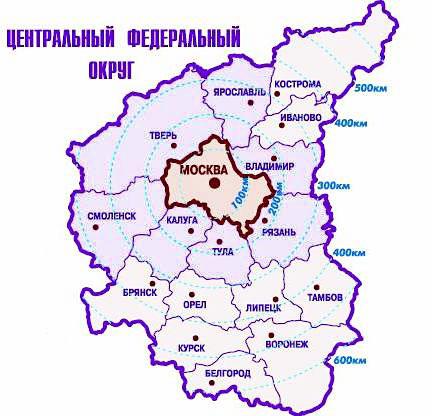Central Russia is a huge inter-district complex. Traditionally, this term was used to refer to territories gravitating to Moscow, on which the Moscow, and subsequently the Russian state, was formed.
General reference
The history of Central Russia, which is the core of our state, began with the formation of Muscovy in the 13th-15th centuries, due to the unification of disparate specific principalities. In the cities of this region there are many architectural, historical and literary monuments and museums. The Golden Ring is widely known throughout the country and even abroad - the ancient cities of Central Russia: Sergiev Posad, Rostov the Great and Pereslavl-Zalessky, Kostroma, Suzdal, Yaroslavl, Vladimir, Ivanovo, Bogolyubovo, Gus-Khrustalny, Gorokhovets, Kalyazin, Kideksha, Murom, Palekh and others. The Golden Ring covers such areas as Moscow, Yaroslavl, Vladimir, Ivanovo, Kostroma. The ancient cities of Central Russia are known for their extraordinary crafts. For example, Fedoskino, Kholuy and Palekh are famous for varnished miniatures, Gzhel - for ceramics, Zhostovo - painted trays, Abramtsevo - wood carvings, Khotkovo - wood carvings, pos. Mstera - lacquered miniatures and woven lace, pos. Krasnoe-on-Volga - jewelry made of copper, brass, silver, Rostov the Great - enamel (miniature painting on enamel).

Stages of development
The formation of this region was influenced by the features of historical development and the economic and geographical position. The central part of Russia is located in the valleys and watersheds of the Dnieper, Oka, Volga and Western Dvina, it had a very favorable position during the formation of the state. Thanks to the river routes, communication was carried out with the outskirts, as well as with neighboring countries. The central region of Russia is the main focus of national culture, hence the resettlement of the Russian people in other territories.
In the early stages of development, the population made extensive use of local natural resources, such as iron ore, coal, forest, limestone, sands, salt, clay, peat and others. Here ferrous metallurgy and metalworking, woodworking, salt production, ceramic and glass, textile and leather and footwear industries were born. In Soviet times, three hydroelectric power plants were built in the region on the Volga, and a pumped storage power plant was built in Sergiev Posad. In addition, in the fifties of the last century, the world's first nuclear power plant began to function in the Kaluga region , and after 20-30 years, the central part of Russia received two more nuclear power plants - in the Tver and Smolensk regions.
Region population
The central district of Russia is the territory where the core of the Russian people was formed. And today the Russian population prevails here. And only in the eastern part, in the Volga-Vyatka region, live the Chuvashs, Mordovians, Mari. According to a census in 2002, just over 38 million people lived in the region. Of these: Russians - 34 million (91%), Ukrainians - 756 thousand (1.99%), Tatars - 288 thousand (0.77%), Armenians - 249 thousand (0.66%), Belarusians - 186 thousand ( 0.49%), Azerbaijanis - 161 thousand (0.43%), and Jews - 103 thousand (0.27%). The remaining nationalities make up less than 0.2%.
Center for Political and Economic Life of Russia
The main features of the region’s modern economy were influenced by the following factors: the role of its constituent areas as the country's main design, training and research bases; the presence of highly qualified personnel; favorable economic and geographical position; highly developed transport links; energy produced in power plants of various types; use of imported raw materials; formation of a metallurgical base and others. Today, Central Russia specializes in the production of complex products that require scientific development and skilled labor. The main areas of specialization are engineering, metallurgy, light and chemical industries. Not the last place is occupied by scientific and technical services and science, as well as higher education, art and culture. In recent years - tourist and sightseeing activities.
Description of economic regions
The central region of Russia includes the following economic regions: Volga-Vyatka, Central Black Earth and Central. Consider the economic and geographical characteristics of each of them. This will help to understand their role on the scale of not only this region, but the whole country.
Volga-Vyatka district
This region includes the following regions of Central Russia: Nizhny Novgorod and Kirov, as well as the republics: Chuvash, Mordovia and Mari El. Its territory is 263 thousand square kilometers. The Volga-Vyatka region is located in the European part of our country, in the basins of the Vyatka and Volga rivers. The geographical position at the intersection of railways and the main waterways connecting the Center with the Volga, Urals, North-West, creates excellent conditions for the development of the economy. The climate here is temperate continental. The whole territory is covered with forests. The main specialization of the district is engineering. In addition, the forestry and chemical industries are well developed. Artisanal crafts, for example, Khokhloma painting, have been preserved and developed to this day.
Central Black Earth Region
The composition of this region includes Belgorod, Voronezh, Lipetsk, Tambov and Kursk regions. It is characterized by a convenient transport and geographical location. Its territory is 107 thousand square kilometers. The presence of rather large deposits of iron ore and cement raw materials, as well as a significant reserve of working hands contribute to the development of various industries, both industry and agriculture. The climate here is temperate continental, natural zones - the steppe and forest-steppe, the relief is mostly flat. Huge masses of chernozems are concentrated in this region, however, most of the territories lack water resources.
The main specialization is determined by the metallurgical, chemical, engineering and food industries, as well as developed agriculture.
central District
The structure of this region includes: Bryansk, Vladimir, Kaluga, Kostroma, Ivanovo, Moscow, Oryol, Smolensk, Tver, Ryazan, Yaroslavl and Tula regions. The economic and geographical position is central, therefore it is advantageous both in transport and in other respects. The area is the main focus of culture. It is not rich in natural resources. As a result, the industry mainly works on imported raw materials. There are reserves of phosphorites, peat, brown coal, limestone, sand. The main specialization is the production of complex, intangible products that require scientific development and skilled labor. The main industries are chemical, light, printing industries and diversified engineering.
The nature of the region
The nature of this region is very diverse - from dense pine forests to the steppes. In the northeastern part of the region there are large amounts of deposits from boulders and loams. They arose during the movement of the glacier. After his retreat, the territories from the left bank of the Oka River to the Moscow River turned out to be very swampy. This landscape is called the Meshchera lowland. Here pine forests grow wildly. There are several lakes on the territory of Central Russia : Chukhlomskoe, Nero, Plescheevo and Galichskoe. Fertile lands generously fertilized with silt formed along these ponds. In addition to wetlands, the area has unsinkable hills: Suzdal, Yuryev and Murom. In the northwest of this region, the Volga River originates, which is characterized by extensive spills; as a result, a tenth of the Tver region is covered by swamps. The waters that collect in these lowlands for a long time can not find a way out. Bryansk region has long been famous for its dense forests. The southern part of the region is mainly represented by steppe expanses.
Conclusion
Summing up, it can be noted that Central Russia is a huge inter-district complex that has the conditions for the creation and development of the national economy. This region is distinguished by its favorable economic and geographical position in the center of the European part of the Russian Federation. However, Central Russia also has serious drawbacks - this is the lack of access to the sea and the low amount of natural resources. But they are compensated by the proximity to the largest industrial region - the Volga Federal District, as well as to the resource-rich region - the European north. In addition, Central Russia is adjacent to foreign economic partners - Belarus and Ukraine.

This region is the most populated and developed in the Russian Federation. The central district of Russia is the most highly urbanized in the country. Although it is inferior to the Northwest in the share of urban residents (80%), it is the first in the whole country in terms of the concentration of citizens in major cities and urban agglomerations.